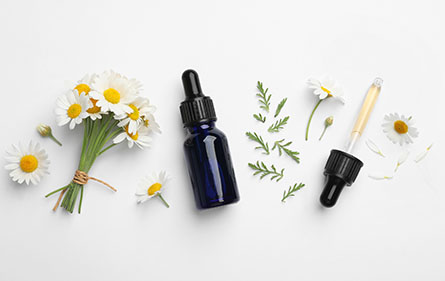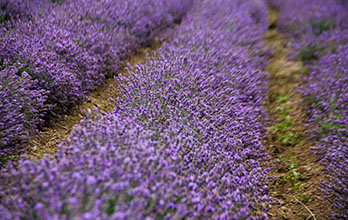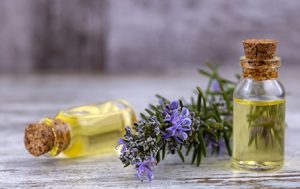Lavender oil is an essential oil obtained by distillation from the flower spikes of certain species of lavender. Two forms are distinguished, lavender flower oil, a colorless oil, insoluble in water, having a density of 0.885 g/mL; and lavender spike oil, a distillate from the herb Lavandula latifolia, having density 0.905 g/mL. Like all essential oils, it is not a pure compound; it is a complex mixture of phytochemicals, including linalool and linalyl acetate. As of 2011, the biggest lavender oil producer in the world is Bulgaria.
Extraction
Pure lavender essential oil is produced through steam distillation. This generates a greater amount of oil compared to other methods due to reduction of polar compound loss.[2] Harvest of lavender blooms are typically around June. Lavender flowers are compacted into a still. Fewer air pockets in the still result in greater oil yield. A boiler is then used to steam the bottom of the lavender flower filled still at a very low pressure. The lavender flower pockets containing oil are broken from this heating process and a pipe of cold water is run through the center of the still. The hot lavender oil vapor condenses on the cold pipe with the cold water and is collected into a holding tank where it is allowed to settle. Due to polarity and densities of the water and oil, these two will separate in the holding tank whereupon the water is piped out, leaving just lavender essential oil.
Uses
1. Lavender oil has long been used in the production of perfume.
2. Oil of spike lavender was used as a solvent in oil painting, mainly before the use of distilled turpentine became common.
3. Lavender oil is used in massage therapy as a way of inducing relaxation through direct skin contact for application.
Composition
The exact composition of lavender essential oil varies from species to species but consists primarily of monoterpeneoids and sesquiterpeneoids. Of these linalool and linalyl acetate dominate, with moderate levels of lavandulyl acetate, terpinen-4-ol and lavandulol. 1,8-cineole and camphor are also present in low to moderate qualities. In all lavender oil typically contains many more than 100 compounds, although a great many of these are present at very low concentrations.
The composition of lavender essential oil as obtained by chromatography:
Safety and precaution
It is contraindicated in pregnancy. When lavender oil takes in high quantity than it causes occurs by the following terms: Vomiting, diarrhea, Blurred on clear vision, difficult to take clear in breath, burning over your eyes, so be care before use of Pure Lavender Oil. In such case call the doctor.
| PHYSICAL PROPERTIES | |
| ODOR | Fresh floral, herbal, rosewood |
| APPEARANCE | Colourless clear Liduid |
| MOLECULAR FORMULA | C10H180 |
| MOLECULAR WEIGHT | 154.24 |
| FLASH POINT | 78⁰C |
| ANALYTICAL SPECIFICATIONS | |
| PURITT (GC%) | 98.00% |
| SPECIFIC GRAVITY (20/4ᵒC) | 0.859 ̴ 0.864 |
| REFRACTIVE INDEX (20ᵒC) | 1.460 ̴ 1.464 |
| ACID VALUE | ≤0.5 |
| PACKAGE | 170kg in steel barrel or 850kg in tote |
| STABILITY | Storage stability min. 24 months in unopened original packaging |
| STORAGE CONDITIONS | Keep in a dry place, in a sealed container |




